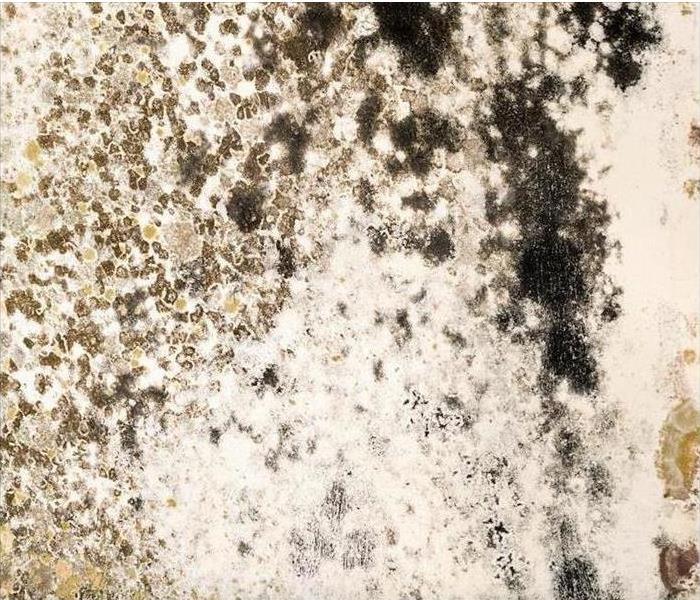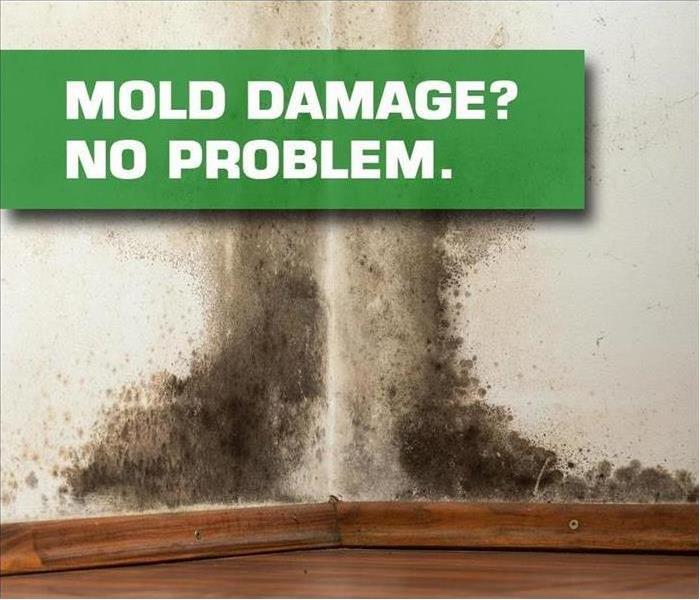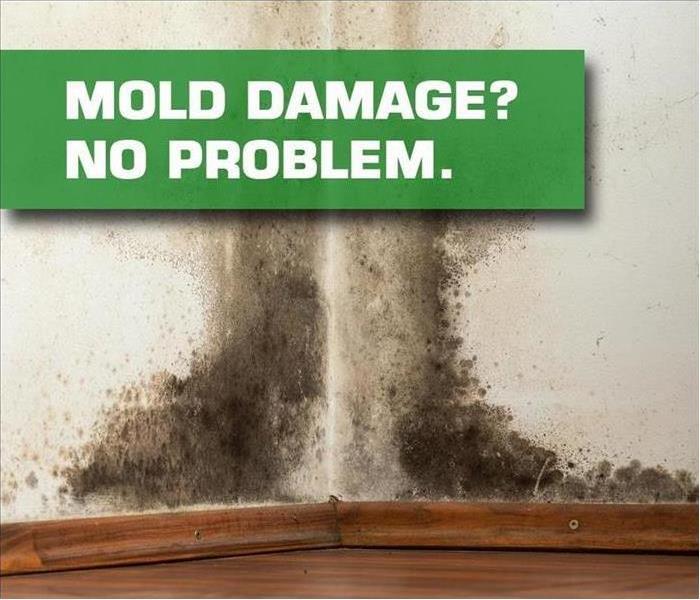Archived Mold Remediation Blog Posts
Why Does SERVPRO Use Containment During Mold Remediation?
2/21/2022 (Permalink)
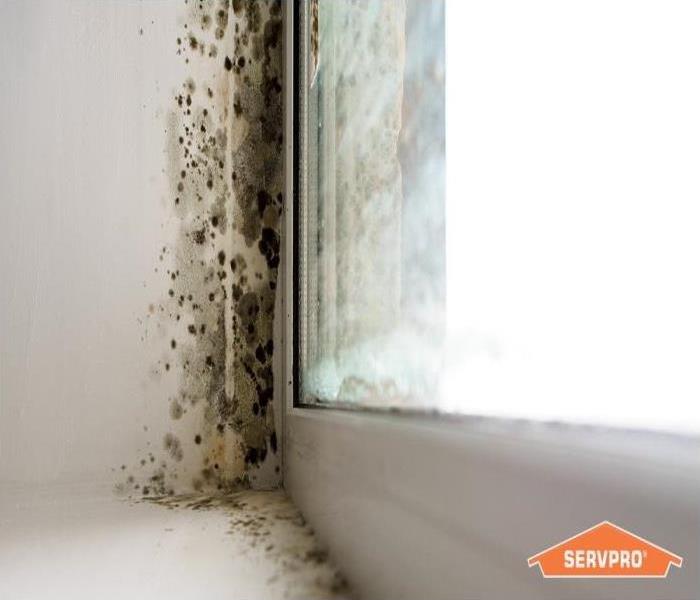 Prevents further damage to your property by making it harder for spores to find a new home elsewhere
Prevents further damage to your property by making it harder for spores to find a new home elsewhere
Riverside Homeowners Can Rely on Us to Control the Spread of Spores
People living in Riverside know that the upkeep of a house is a significant undertaking. There are always items needing repairing or replacing, and there is a list of chores each week. Some jobs require professional help, and you need a company on which you can rely.
If you need mold remediation in Riverside, SERVPRO is your go-to remediation company. We put our technicians through a comprehensive training program, which is the Institute of Inspection, Cleaning, and Restoration Certification certified. Our services are available all day, including on holidays, so you know we have always got your back.
Proper containment procedures are an essential part of our technician training. But what is containment – and why does it matter to you?
How does mold travel?
To understand the necessity of containment, it helps to know how mold travels. Mold spores are microscopic. The mold growth you see as black patches is a network of tiny tube-like filaments called hyphae. A mold colony comprises many hyphae, and the mold grows and lives in areas that provide moisture and a food source.
Unfortunately, mold does not just stay in its colony. Tiny mold spores can break free and become airborne. Once the mold is in the air, it can attach to clothes, bags, shoes, and even pets. It can also enter the home through doors and windows. If the breakaway mold spores find another location with moisture, oxygen, and a food source, they can form a new colony.
How does containment help?
Containment makes it harder for mold spores in Riverside to leave the affected area. If it is harder for spores to go, they are less likely to travel and set up a new colony in another part of your home.
Containment does not only stop mold spores, however. It is also helping to prevent the spread of:
- Silica dust
- Asbestos
- Lead-based paint
- Leftover soda crystal particles from soda blasting
Containment means we keep the contamination in one area, which makes it easier to handle and produces better long-term results for you.
What exactly is containment?
There are two main types of containment.
We use limited containment for smaller areas (usually less than 100 square feet). SERVPRO technicians wrap the affected area in a single layer of polyethylene sheeting. We use tape to seal up all windows, doors, ducts, and vents to close off potential exit points. The sheeting contains a slit for entry and exit covered by a flap when not in use.
We use full containment in larger areas, or more severe cases of mold. Full containment includes two layers of polyethylene sheeting and the addition of a decontamination area. SERVPRO employees use this area to decontaminate themselves and their equipment before entering the rest of your home.
Are there any other benefits of containment?
Yes. As well as stopping the spread of mold or other harmful particles throughout your home, containment:
- Prevents further damage to your property by making it harder for spores to find a new home elsewhere
- Makes the cleanup process much easier
- Ensures we carry out mold remediation in the safest possible environment
What about air filtration?
Air filtration is an essential part of containment. We use powerful air scrubbers, equipped with HEPA filters, to pull microscopic spores from the air and trap them. The HEPA filters are small enough to capture tiny mold spores, as well as other airborne contaminants.
In some cases, we also use negative air machines. While air scrubbers are self-contained units, negative air machines vent the contaminated air outside of your home. They create a vacuum to prevent mold from becoming airborne and escaping.
Does containment stop mold?
It is impossible to ensure that mold will never take hold in your home again. Because it can enter through doors, windows, on your clothes, or your pets, we cannot truthfully say it will not come back. However, containment means that the mold spores in the currently contaminated area cannot spread. And if they cannot spread, they cannot set up new colonies.
Containment is highly effective for treating the current mold infestation and discouraging spores from traveling elsewhere. We also use moisture meters and sensors, and thermal-hygrometers, to monitor moisture levels in the affected area, so there is less moisture to feed mold.
We also use highly effective cleaning procedures such as baking soda blasting to clean away as many visible colonies as possible. The combination of containment with effective remediation makes your home much less friendly to mold spores and removes existing colonies. If you need help with mold remediation, give SERVPRO of West Riverside City a call at (951) 351-8033.
What Conditions Does Mold Grow In?
1/31/2022 (Permalink)
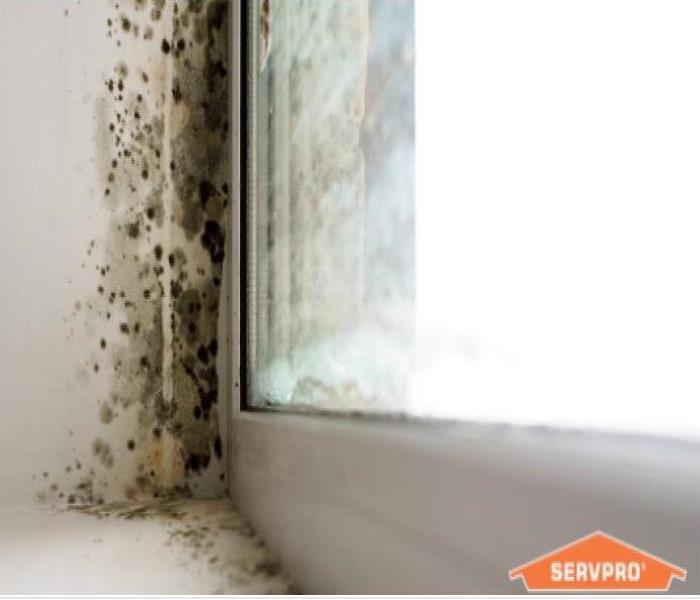 If you've discovered mold in your property, give us a call about removing it.
If you've discovered mold in your property, give us a call about removing it.
While mold is a preventable problem, if it does break out, it can be a serious issue to tackle for homeowners, and if it is not handled properly from the beginning, it can quickly return on a repeat basis.
Fortunately, there are things that every homeowner can do to prevent mold from growing in the first place—namely, by avoiding creating conditions where it is likely to thrive. Below, we will take a look at how mold finds its way into your home as well as the conditions that it likes so you can be on the lookout for susceptible places in your home.
How Does Mold Get Into a Home?
Mold spores are airborne, and they can easily be transported from the outdoors to the inside of a home when the door is opened, when people walk inside with their shoes on or when pets and people carry the spores in on their fur or clothes.
Mold is nearly everywhere, which is normally not an issue because it needs a very specific set of conditions to begin to grow and reproduce.
An indoor mold problem can show itself in different ways. Some common indicators include:
Visible mold growthMusty or moldy smellStaining/discoloring of the ceiling or walls (water damage stains)Known leak or water damage (within the past few years)Any of the above should bring about concern with property owners or occupants as they can be an indicator of an indoor mold problem.
Unfortunately, while these conditions should warrant a reaction, many people don’t react until their health or the health of someone they know is impacted.
Despite the indicators, addressing a potential mold problem is important. The first step in this process is to verify whether or not you actually have a problem and, if one is present, the size of the problem.
Several environmental inspection companies are available to investigate a property to determine if a harmful mold growth and environmental contamination exists. During the property inspection, samples of the air and surfaces may be taken during the mold testing process. These samples should then be analyzed by an independent third party lab to detect the presence or absence of mold growth within the area in question.
The Conditions That Mold Finds Favorable
There are many different types of mold that may grow in areas, but they all have one thing in common: They cannot grow without an adequate amount of moisture.
Mold requires dampness to take hold and begin reproducing, which is why it is often found in basements, bathrooms and areas that have experienced water damage.
An indoor mold problem can show itself in different ways. Some common indicators include:
Visible mold growthMusty or moldy smellStaining/discoloring of the ceiling or walls (water damage stains)Known leak or water damage (within the past few years)Any of the above should bring about concern with property owners or occupants as they can be an indicator of an indoor mold problem.
Despite the indicators, addressing a potential mold problem is important. The first step in this process is to verify whether or not you actually have a problem and, if one is present, the size of the problem.
Several environmental inspection companies are available to investigate a property to determine if a harmful mold growth and environmental contamination exists. During the property inspection, samples of the air and surfaces may be taken during the mold testing process. These samples should then be analyzed by an independent third party lab to detect the presence or absence of mold growth within the area in question.
If the investigation of the property concludes that the indoor environment is unsafe, mold remediation should be pursued. It is not recommended that mold be remediated by a private party, regular contractor, or maintenance worker as this can exacerbate the problem. The best choice for mold remediation is a professional mold remediation or damage restoration company that is experienced and certified in environmental remediation and decontamination such as SERVPRO of West Riverside City.
How Can I Discourage Mold From Growing?
One of the best things that homeowners can do to prevent mold from growing is increasing circulation and not letting areas in the home become too humid. Adding a fan to a bathroom or installing a dehumidifier in a basement can go a long way in discouraging mold from making itself at home.
Additionally, if you have any water damage to your home, it is best to get it professionally restored right away so mold does not begin to grow in the damaged area.
If you need help with mold remediation or water damage restoration, we are here to help.
If the investigation of the property concludes that the indoor environment is unsafe, mold remediation should be pursued. It is not recommended that mold be remediated by a private party, regular contractor, or maintenance worker as this can exacerbate the problem. The best choice for mold remediation is a professional mold remediation or damage restoration company that is experienced and certified in environmental remediation and decontamination such as SERVPRO of West Riverside City.
Riverside Business- 5 Steps to Minimize Mold Risk During and After a Prolonged Shutdown
10/12/2020 (Permalink)
Mold will grow on building materials where there is moisture, produced from leaks or condensation from roofs, windows, or pipes, or from a flood.
Mold can grow on a variety of surfaces, such as ceiling tiles, wallpaper, insulation, drywall, carpet, and fabric. People with asthma and other respiratory conditions and those with mold allergy or weakened immune systems should avoid buildings suspected or confirmed to have mold contamination. Ensure that your building does not have mold after a prolonged shutdown to maintain a safe working environment for returning occupants. Here are 5 steps from CDC.gov:
5 steps to minimize mold risk during and after a prolonged shutdown
- Maintain indoor humidity as low as possible, not exceeding 50%, as measured with a humidity meter. Building managers may consider continuous monitoring of indoor humidity using a digital hygrometer, ideally more than once daily, to minimize the need to access the building.
- After a prolonged shutdown and before occupants return, buildings should be assessed for mold and excess moisture.
- Building inspections by trained industrial hygienists can recognize dampness or mold by sight or odor, without the need for sampling and laboratory analysis. NIOSH offers tools and instructions to assess dampness and mold in schools and general buildings. These tools can be used by building maintenance staff as well as industrial hygienists.
- If dampness or mold is detected, address the source of water entry first. Clean-up and remediation should then be conducted before the building is reoccupied. Plan the remediation before beginning work. Resources for remediation of buildings and homes with mold are provided by NIOSH, the, the EPA, and CDC .
- After an assessment has confirmed that mold and moisture are not detected (Step 2a), OR after remediation has been completed (Step 2b), a building HVAC system that has not been active during a prolonged shutdown should be operated for at least 48 to 72 hours (known as a “flush out” period) before occupants return.
- During this period, open outdoor air dampers to the maximum setting that still allows desired indoor air temperatures.
- If an odor is detected that suggests mold growth (such as a musty smell) after the “flush out” period, look for mold that may not have been identified earlier. If mold is found, conduct remediation as described in Step 2b.
- Continue the “flush out” process until no odors are apparent.
- The condition of HVAC filters used during the “flush out” period should be carefully assessed prior to building occupancy and replaced with new or clean filters as necessary.
- After a building is reopened and occupied, routine (e.g., weekly) checks of the HVAC system are recommended to ensure operating efficiency.
- During HVAC checks, inspect and replace filters as indicated or needed.
- The frequency of HVAC system checks can be gradually reduced (e.g., monthly, quarterly), depending on the operational and maintenance specifications for the HVAC system.
- Maintain indoor temperature and relative humidity within ranges recommended.
- If no routine HVAC operation and maintenance program is in place for the building, one should be developed and implemented. At a minimum, consider including the following:
- Inspection and maintenance of HVAC components
- Calibration of HVAC system controls
- HVAC testing and balancing
Give SERVPRO of West Riverside City a call to inspect your facility if you smell mildew or see signs of mold growth.
Homeowner’s and Renter’s Guide to Mold Cleanup After Disasters
3/4/2020 (Permalink)
Cleaning up after a flood can pose health risks. You and your family should wait to re-enter your home until professionals tell you it is safe, with no structural, electrical or other hazards.
Before you start cleanup activities, contact your insurance company and take pictures of the home and your belongings. Remember – drying your home and removing water-damaged items is your most important step for preventing mold damage.
Is There a Problem?
Was your home flooded? If so, and you were not able to dry your home (including furniture and other items) within 24-48 hours, you should assume you have mold growth. You need to completely dry everything, clean up the mold, and make sure you don’t still have a moisture problem.
You may see or smell mold on clothing, drywall, furniture, cardboard boxes, or books, but it may also be hidden under or behind items like carpet, cushions, or walls.
Mold Basics:
Flood water may have carried sewage or chemicals into your home. This could expose you or your family to viruses, bacteria, disease carriers (such as mosquitoes), and parasites, as well as mold. To learn more about cleaning and disinfection go to: www.cdc.gov/healthywater/emergency/flood/standing.html.
You can protect yourself and your family from mold exposure by following these steps.
Before You Enter Any Moldy Site:
Protect yourself and loved ones against hazards. People with breathing problems like asthma or who have weakened immune systems should stay away from moldy sites. Children should not take part in disaster cleanup work. Check for loose power lines or gas leaks. Make sure the electricity and gas are turned off. Look for sagging ceilings or floors or other structural problems. Watch out for wet, muddy, or slippery floors.Protect your mouth and nose against breathing in mold: wear at least an N-95 respirator. If you plan to spend a lot of time removing moldy belongings or doing work like ripping out moldy drywall, wear a half-face or full-face respirator. Basic information on using it is in OSHA’s general respiratory protection guidance. Protect your skin. Wear protective gloves (non-latex, vinyl, nitrile, or rubber). Do not touch mold or moldy items with bare hands.Protect your eyes. Wear goggles that provide complete eye protection. Choose goggles designed to keep out dust and small particles. Safety glasses or goggles that have open vent holes will not protect you against dust and small particles.After You Leave a Mold Site:
Protect yourself and loved ones. Shower and change your clothes. This will help you avoid carrying mold and other hazards back to your current living quarters.Should I Do This Myself?
This job may be too difficult or dangerous for you. It may be best to get help from experienced and qualified professionals if you can. Hire a mold inspection or remediation professional affiliated with or certified by the National Environmental Health Association (NEHA), the American Industrial Hygiene Association (AIHA), the Institute of Inspection, Cleaning and Restoration Certification (IICRC), or American Council for Accredited Certification (ACAC) to inspect, repair, and restore the damaged parts of your home. Your state also may regulate mold remediation.
Sampling for mold is not usually recommended. Understanding the results can be difficult, and no matter what kind of mold is in your home, you need to clean it up and fix the moisture problem.
If I Must Do This Myself, How Can I Do It Safely?
Follow these steps:
Put on the personal protective equipment described above to protect your eyes, nose, mouth, and skin.Remove standing water and wet materials. Use a wet vacuum to remove water from floors, carpets, and hard surfaces. Dry your home and everything in it as quickly as you can – within 24 to 48 hours if you can.Open all doors and windows when you are working and leave as many open as is safe when you leave.Open inside doors, especially closets and interior rooms, to let air flow to all areas. Take doors off their hinges if you need to.Open kitchen cabinets and bathroom vanity doors; remove drawers, wipe them clean, and stack them to dry.Open the attic access to let air flow to the attic. Before you open the attic door, make sure nothing will fall on you.When electricity is safe to use, use fans and dehumidifiers to remove moisture. Do not use fans if mold has already started to grow, because the fans may spread the mold.Clean with water and a detergent. Remove all mold you can see. Dry right away.If you use cleaning products, do not mix cleaning products together. DO NOT mix bleach and ammonia because it can create toxic vapors.Painting or caulking over mold will not prevent mold from growing. Fix the water problem completely and clean up all the mold before you paint or caulk.Throw away items that can’t be cleaned and dried. Throw away anything that was wet with flood water and can’t be cleaned and dried completely within 24 to 48 hours. If you have precious items that you want to preserve, follow these guidelines from the Smithsonian Institute: www.si.edu/mci/english/learn_more/taking_care/mnm.htmlExternal.
Mold Prevention that Work for Your Riverside Home
11/11/2019 (Permalink)
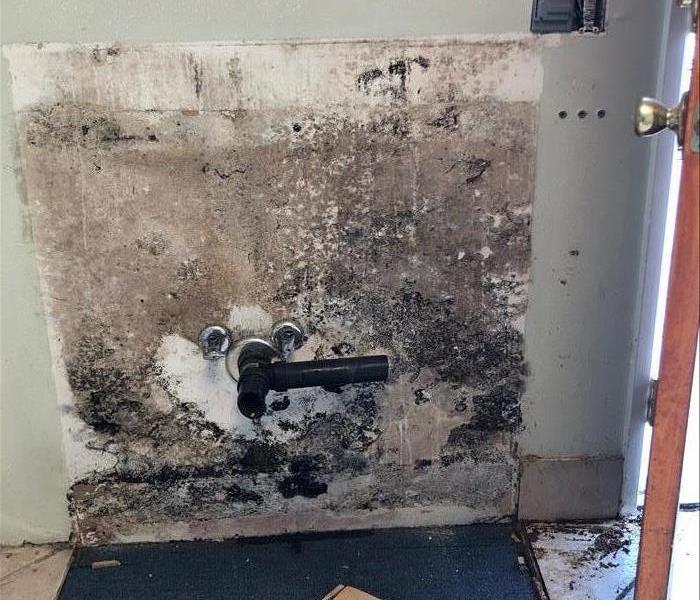 SERVPRO of West Riverside City specializes in mold cleanup and restoration, Our crews are highly trained restoration professionals.
SERVPRO of West Riverside City specializes in mold cleanup and restoration, Our crews are highly trained restoration professionals.
Although there are a variety of challenges that residential and commercial property owners can experience, the presence of mold is particularly problematic.
This is the case for many reasons, including the fact that mold can cause health problems and decrease the structural integrity of one’s property. There are ways to prevent the growth of mold, but your best course of action is hiring a professional mold remediation company. Try implementing some or all of the following six mold prevention tips:
Invest In A Dehumidification System.One of the best ways to prevent the growth and proliferation of mold is to invest in an air conditioner that features a dehumidification system. These systems are effective in removing moisture from your property. Once the moisture is removed, the mold is deprived of one of the vital nutrients that help it grow.
Be Cautious When Turning The AC Off.Make sure that you are cautious when you turn off your air conditioner. In climates that are humid, a long-standing period of inactivity can enable humidity levels to become dangerously high. If the humidity level becomes extremely high, it creates the moist environment necessary for mold to grow and thrive.
Use Insulation.Another strategy you can use to prevent mold is the use of insulation. By installing insulation as well as vapor barriers, you can prevent condensation from accumulating on objects like plumbing fixtures, beams, and water pipes.
Avoid Standing Water.Stagnant water can become a breeding area for mold. Since this is the case, make sure that you keep your tubs, showers, sinks and all other wet regions of your property free of standing water.
Review Your Applications.Another strategy for mold prevention is application review. Make sure that all of your construction, design, and architectural applications are effective in preventing water from coming in contact with the interior of your property and goods. Specific regions of concern include poorly designed balconies, pitched roofs, improperly installed flashing, doors, windows, thin stucco, and vapor barriers.
Maintain Structure Regularly.One final way to help prevent mold growth is to ensure that the integrity of your building envelope is maintained. You can achieve this objective by investing in regular roof flashing, caulking, sealing, and inspections of the exterior.
Conclusion
Mold can be a severe problem for residential and commercial property owners to handle. However, using the prevention tips and tricks outlined above can help you keep your property mold-free. In the event that mold growth does transpire, call a professional restoration company. They have extensive experience in the mold remediation field and can assist with your mold restoration needs.
If you suspect Mold
If you see visible mold, do not disturb it. You can inadvertently spread the mold infestation throughout your home. When mold is disturbed, the mold can release microscopic mold spores which become airborne and can circulate inside your home.
What to Do:
· Stay out of affected areas.
· Turn off the HVAC system and fans.
· Contact SERVPRO of West Riverside City for mold remediation services.
What Not to Do:
· Don’t touch or disturb the mold.
· Don’t blow air across any surfaces with visible or suspected mold growth.
· Don’t attempt to dry the area yourself.
· Don’t spray bleach or other disinfectants on the mold.
About Our Mold Remediation Services
SERVPRO of West Riverside City specializes in mold cleanup and restoration, in fact, it’s a cornerstone of our business. Our crews are highly trained restoration professionals that use specialized equipment and techniques to properly remediate your mold problem quickly and safely.
If You See Signs of Mold, Call Us Today – SERVPRO of West Riverside City 951-351-8033
Does Bleach Remove Mold from your Riverside home?
6/12/2019 (Permalink)
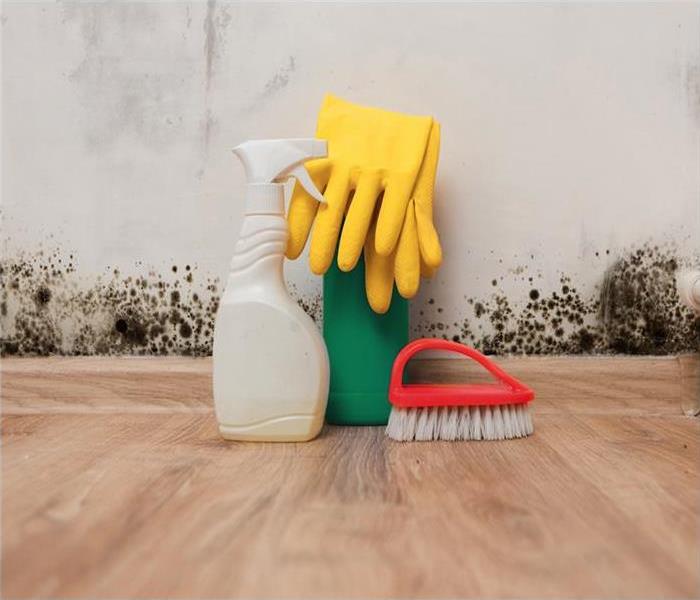 For the best cleanup results and the lowest change of regrowth, contact a mold damage cleanup and remediation company.
For the best cleanup results and the lowest change of regrowth, contact a mold damage cleanup and remediation company.
Consistent exposure to mold has a very negative effect on your family and your home or Business.
The negative consequences of mold exposure can easily go undetected and cause serious problems.
A building owner or manager may want to know whether bleaching mold is an affordable and effective alternative to professional cleanup.
Even if only a small amount of mold can be seen, it is likely you have a bigger problem below the surface.
Take action to remove the problem permanently and safely. Here is what you need to know...
Bleach can kill virtually every species of indoor mold that it comes into contact with. However, using bleach only works if the mold is growing on non-porous materials like tile, tubs, and counter tops. That’s because bleach can’t penetrate porous materials such as wood and drywall. Using bleach on such materials can be deceiving because it will kill the mold above the surface, but mold below the surface will remain. Bleach can be useful but it can also cause damage; it's a harsh, corrosive chemical that gives off harsh fumes. There are safer alternatives.
Cannot Eliminate Hyphae
The multicellular filaments that form during mold growth often go deeper than the surface of a material. Disinfecting or sanitizing surfaces may not eliminate the presence of hyphae, or underlying root structures, and will not be effective for inhibiting future mold growth. If moisture levels remain high and food sources such as cellulose or dust are still available, mold that has been bleached may regrow on non-porous, semi-porous or porous surfaces.
May Damage Materials
A building owner or manager should consider the effects of cleaning solutions on any material supporting mold growth. Chlorine-based solutions may damage delicate materials. Oxygen-based formulas are gentler and safer, but are still not ideal for treating mold on most surfaces. Mold damage experts can recommend more effective fungicides to cleanup mold and inhibitors for prevention or will tear out and replace ruined materials.
Borax is a natural, white mineral powder that has a low toxicity and does not emit dangerous fumes. It can be mixed with water to kill and remove mold because it is a natural mold inhibitor.
Vinegar is a mild acid that can kill 82% of mold species. It’s also natural and safe. Vinegar is non-toxic and doesn't emit dangerous fumes.
Fungicides are more effective than bleach for stopping mold growth. Some treatments may require safety precautions. For the best fungus cleanup results and the lowest change of regrowth, building owners or managers should contact a mold damage cleanup and remediation company in Riverside, CA.
Removing mold can be serious business. When removing mold wear a respirator or face mask and cover your arms, legs and hands to avoid contact with mold spores. You should safely be able to take on bathroom mold or relatively small mold outbreaks in other areas if you take these precautions. For larger problems, especially problems where hidden mold may be a problem, it’s probably wise to call a reputable professional.
Every mold infestation is different, from the amount of mold to the types of materials affected. Each scenario requires a unique solution, but the general process stays the same. The steps listed below illustrate the process for a “typical” mold remediation infestation by a professional:
Inspection and Mold Damage AssessmentMold ContainmentAir FiltrationRemoving Mold and Mold-Infested MaterialsCleaning Contents and BelongingsRestorationSERVPRO of West Riverside City is a trusted leader in the restoration industry. We provide 24-hour emergency service and are dedicated to responding faster to any size disaster. With the training and expertise to handle your restoration and cleaning needs, we’re locally owned and operated and can respond immediately to your emergency. Call us at 951-351-8033, we are here to help!
The Key to Mold is Moisture Control from our friends at EPA.gov
4/29/2019 (Permalink)
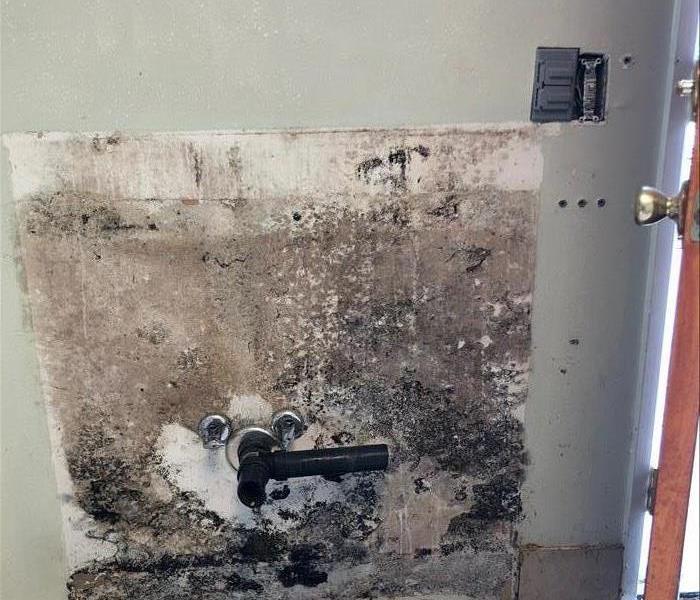 If you already have a mold problem – ACT QUICKLY. Mold damages what it grows on. The longer it grows, the more damage it can cause.
If you already have a mold problem – ACT QUICKLY. Mold damages what it grows on. The longer it grows, the more damage it can cause.
Why is mold growing in my Riverside home?
Molds are part of the natural environment. Outdoors, molds play a part in nature by breaking down dead organic matter such as fallen leaves and dead trees, but indoors, mold growth should be avoided. Molds reproduce by means of tiny spores; the spores are invisible to the naked eye and float through outdoor and indoor air. Mold may begin growing indoors when mold spores land on surfaces that are wet. There are many types of mold, and none of them will grow without water or moisture.
How do I get rid of mold?
It is impossible to get rid of all mold and mold spores indoors; some mold spores will be found floating through the air and in house dust. The mold spores will not grow if moisture is not present. Indoor mold growth can and should be prevented or controlled by controlling moisture indoors. If there is mold growth in your home, you must clean up the mold and fix the water problem. If you clean up the mold, but don’t fix the water problem, then, most likely, the mold problem will come back.
Mold Cleanup
Who should do the cleanup?
Who should do the cleanup depends on a number of factors. One consideration is the size of the mold problem. If the moldy area is less than about 10 square feet (less than roughly a 3 ft. by 3 ft. patch), in most cases, you can handle the job yourself, following the guidelines below. However:
¦ If there has been a lot of water damage, and/or mold growth covers more than 10 square feet, consult the U.S. Environmental Protection Agency (EPA) guide: Mold Remediation in Schools and Commercial Buildings. Although focused on schools and commercial buildings, this document is applicable to other building types. It is available on the Internet at: www. epa.gov/mold.
¦ If you choose to hire a contractor (or other professional service provider) to do the cleanup, make sure the contractor has experience cleaning up mold. Check references and ask the contractor to follow the recommendations in EPA’s Mold Remediation in Schools and Commercial Buildings, the guidelines of the American Conference of Governmental Industrial Hygenists (ACGIH), or other guidelines from professional or government organizations.
¦ If you suspect that the heating/ventilation/air conditioning (HVAC) system may be contaminated with mold (it is part of an identified moisture problem, for instance, or there is mold near the intake to the system), consult EPA’s guide Should You Have the Air Ducts in Your Home Cleaned? before taking further action. Do not run the HVAC system if you know or suspect that it is contaminated with mold - it could spread mold throughout the building. Visit www.epa. gov/iaq/pubs to download a copy of the EPA guide.
¦ If the water and/or mold damage was caused by sewage or other contaminated water, then call in a professional who has experience cleaning and fixing buildings damaged by contaminated water.
¦ If you have health concerns, consult a health professional before starting cleanup.
Mold Clean Up Guidelines
6 Tips and techniques
The tips and techniques presented in this section will help you clean up your mold problem. Professional cleaners or remediators may use methods not covered in this publication. Please note that mold may cause staining and cosmetic damage. It may not be possible to clean an item so that its original appearance is restored.
¦ Fix plumbing leaks and other water problems as soon as possible. Dry all items completely.
¦ Scrub mold off hard surfaces with detergent and water, and dry completely. Places that are often or always damp can be hard to maintain completely free of mold. If there’s some mold in the shower or elsewhere in the bathroom that seems to reappear, increasing the ventilation (running a fan or opening a window) and cleaning more frequently will usually prevent mold from recurring, or at least keep the mold to a minimum.
¦ Absorbent or porous materials, such as ceiling tiles and carpet, may have to be thrown away if they become moldy. Mold can grow on or fill in the empty spaces and crevices of porous materials, so the mold may be difficult or impossible to remove completely.
¦ Avoid exposing yourself or others to mold (see discussions: What to Wear When Cleaning Moldy Areas and Hidden Mold.)
¦ Do not paint or caulk moldy surfaces. Clean up the mold and dry the surfaces before painting. Paint applied over moldy surfaces is likely to peel.
¦ If you are unsure about how to clean an item, or if the item is expensive or of sentimental value, you may wish to consult a specialist. Specialists in furniture repair, restoration, painting, art restoration and conservation, carpet and rug cleaning, water damage, and fire or water restoration are commonly listed in phone books. Be sure to ask for and check references. Look for specialists who are affiliated with professional organizations.
Bathroom Tip
Places that are often or always damp can be hard to maintain completely free of mold. If there’s some mold in the shower or elsewhere in the bathroom that seems to reappear, increasing the ventilation (running a fan or opening a window) and cleaning more frequently will usually prevent mold from recurring, or at least keep the mold to a minimum.
A qualified restoration company understands the science behind mold and mold growth. SERVPRO Franchise Professionals have the training and expertise to remediate the mold in your home or business. Mold remediation focuses on getting mold levels back to normal, natural levels.
If you need a remediation company, call SERVPRO of West Riverside City 951-351-8033
See full document at A Brief Guide to Mold, Moisture, and Your Home
Black Mold and your Dog
3/13/2019 (Permalink)
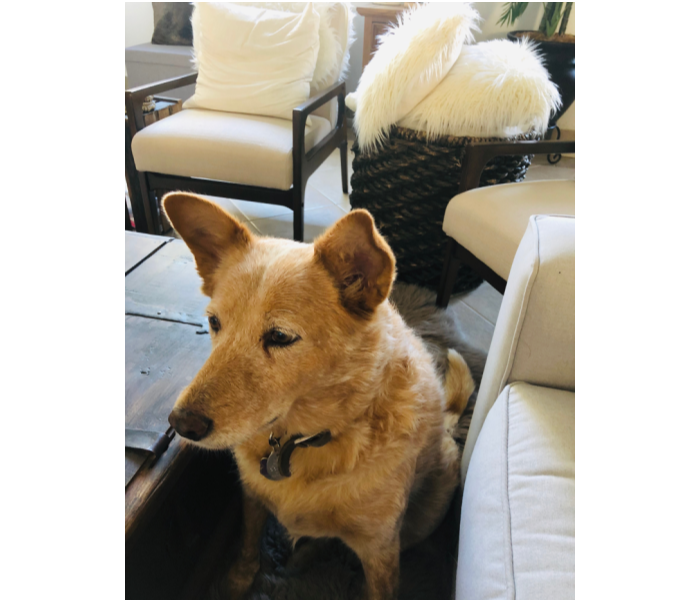 Ellie, our mascot, appreciates the care we take for all furry friends.
Ellie, our mascot, appreciates the care we take for all furry friends.
The impacts to our furry friends. From our friends at WAG:
When we find black mold in our homes, we are often surprised. For many people, black mold is found as a result of a home renovation or just moving an appliance that has been in place for many years. People can become sick from black mold for years before they understand what has caused them to be so ill. This exposure to black mold can make your dog sick as well. Much like infants and the elderly, dogs tend to be more susceptible to illnesses related to black mold than their adult owners.
Signs and Symptoms
Symptoms common to black mold exposure appear in other conditions as well. It is easy, as happens with humans, to treat symptoms of black mold exposure in your dog as different conditions or illnesses. If your dog has been exposed to black mold, you may see some of the following symptoms:
Excessive licking, especially on your dog's pawsLoss of fur in small areasCoughing Sneezing Discharge from eyes and noseNoisy or labored breathingLethargy and listlessnessLack of appetiteBehavioral changesCare and Treatment
If your dog is affected by black mold, you will need to do two things. The symptoms of black mold exposure will need to be treated by your veterinarian. Your veterinarian may prescribe antibiotics for symptoms such as bacterial infections in the lungs or on your dog’s skin. Your dog may also be prescribed steroids or other drugs depending on how long their exposure was and how sick the dog is. Your doctors may also request you not return the dog to the home until the black mold has been mitigated. Working in your dog's best interest, it might also be recommended you and your animals say out of the home until removal is complete, because treatment will not help if exposure to mold continues.
The second step of caring for your dog who has after black exposure is complete mold removal. Black mold within your home affects humans as well as your dogs. To continue medical treatment for yourself as well as for your dog and improve efficacy, the mold will have to be completely removed from the home. The Environmental Protection Agency, or EPA, recommends hiring a mold remediation team because of their professional training if the mold discovered in your home covers an area greater than ten square feet, if black mold is caused by contaminated water or sewage, or if you have mold within your air duct system. If you are comfortable removing the mold on your own, be sure to clean the hard to reach spots and do your research on do-it-yourself mold removal to reduce the number of spores released into the air and onto your skin during the removal process.
Risk and Prevention
Dogs who are exposed to black mold can have more serious health problems than some owners face when exposed to black mold. The only way to prevent black mold exposure from recurring is to ensure the mold is completely removed. Black mold can cause serious illness in humans as well as for their pets. If you suspect your dog has been exposed to black mold or if your dog is sick for extended periods of time with no diagnosis and no relief, consider taking him to your veterinarian for testing of mold exposure. Some areas of the United States are more susceptible to black mold growth, such as moist, humid climates where weather brings rain, hurricanes, or flooding often. However, even in a dry climate, a leak from faulty refrigerator water line for an extended period of time could cause black mold growth within your home.
Read more at: https://wagwalking.com/wellness/black-mold-and-your-dog
Tips for Keeping Your Pet Safe From Mold
A good rule of thumb is to develop the habit of keeping anything your pet comes in contact with clean and dry:
Keep pet food in a sealed container in a cold, dry area (freezer)Wash food and water bowls at least once a day and throw out plastic dishesLaunder your pet's bedding frequently, and immediately if it becomes dampWash pet toys once a weekWhat Should You Do If You Spot Mold in Your Home?
If the issue is small and contained, you can usually tackle it on your own by washing the surface with a soap and water solution. However, if you face recurring or widespread growth, hire a professional mold remediation team.
If mold is putting your household’s health at risk, the trusted professionals at SERVPRO® of West Riverside City will put your home on the path to wellness. As leading mold remediation and restoration service experts, we know how to tackle mold growth strategically. Equipped with heavy-duty cleaning tools, our crews will not only remove spots, but also implement solutions to control moisture and prevent the problem from returning.
To arrange fast and effective clean-up, call a helpful representative at 951-351-8033 today. We care about your family and that includes your beloved pets.
Tips to prevent mold in your Kitchen and bathroom
12/24/2018 (Permalink)
Bathroom and kitchen mold can often be very frustrating. But hopefully with these quick tips you can learn the causes of bathroom and kitchen mold and how you can prevent it.
8 Ways to help prevent mold growth in your kitchen:
Cooking and eating both require a lot of food and moisture, which makes your kitchen a top-notch room for mold growth. Food spoils, water splashes, and crumbs can get everywhere. Implement the following 8 tips to prevent mold from growing in your kitchen.
Keep surfaces dry: Mold loves moisture, so it’s important to keep kitchen surfaces dry. Immediately wipe up spills on the floor, counter-tops, or table. Rinse and wipe out the sink after doing dishes. Make sure your dishes and cutlery are dry before putting them into cabinets.Take out the trash: Leftover food, packaging, and other garbage makes your trash can a perfect place for mold to grow. Make sure to take out your kitchen garbage bin regularly to prevent mold growth.Use the exhaust fans: Humid environments are ideal for mold. When you cook on your stove, moisture can flood the air and condensate around the area. To cut down on humidity, use the exhaust fans when you use the stove-top.Clean the fridge: Old, spoiled food containers are one of the most common places to find mold in a kitchen. Clean out your fridge once a week to prevent food from spoiling and growing mold.Watch your fruit and potatoes: It doesn’t take long for fruit or potatoes to start growing mold, so it’s important to examine all fruit and potatoes on a daily basis, especially if you don’t keep them in the refrigerator.Clear the garbage disposal: Food can gather out of site within your garbage disposal. Even if your sink drains well, you should clean the disposal regularly. Remember to run it daily to clear out the debris. You should also pour vinegar down it weekly.Wash your cutting boards: Food particles and moisture can settle into your cutting boards, which gives mold everything it needs to grow. Use vinegar to wash your cutting boards at least once a week.Sweep and mop regularly: It’s easy for crumbs and other food particles to build up on your floor over just a few days. Sweep the floor every day, and mop it weekly.9 Tips to reduce mold growth in your bathroom:
Mold loves dark, damp areas, which makes bathrooms an ideal environment for it to grow. Regular showers and baths keep the room moist, and various crevices provide perfect spaces for mold to flourish. However, you can help prevent mold growth in your bathroom with these nine tips.
Regularly Wash Your Rugs and Shower Curtain. These items retain water longer than other surfaces in the bathroom, so they are perfect targets for mold. Most rugs and fabric curtains can go in the washing machine, but read their tags for specific instructions. To clean plastic liners, simply soak them in your tub in either a mix of water and all-purpose cleaner or water and bleach for a half an hour. Replace these items as necessary.Turn on the Ventilation Fan. Whenever you bathe or shower, make sure to turn on the bathroom ventilation fan. Keep it on until your bathroom is dry. The bathroom will, weather permitting, dry even faster if you open windows and doors.Air Out the Curtain and Towels. After showering, make sure to extend your shower curtain. If it’s scrunched up, it will take longer to dry, and mold may start to grow in the folds. Hang up your towels and pick up any clothes off the floor so they will dry faster as well.Check for Leaks. Regularly examine all bathroom fixtures. Don’t forget the pipes under the sink. Water from small leaks can provide the perfect breeding ground for mold.Wipe Down Bathroom Surfaces. If you have a glass shower, make sure to squeegee the excess water off the glass panes before you hop out of the shower. Wipe any moisture accumulation off the bathroom walls and flooring as well.Manage Household Humidity Levels. If your house is already humid, it will be more difficult for your bathroom to dry out after a shower. If your house feels humid you can use the AC or a dehumidifier to help.Keep the Clutter Out of the Shower/Tub. Avoid storing toys, shampoo bottles, loofahs, and washcloths in the shower. These items often help retain moisture in the bathroom and all give mold an ideal location to grow and hide. Try storing bottles, washcloths, toys, etc. in wire hanging baskets, in mesh nets, or on hooks that will allow everything to drip dry.Clean the Bathroom Weekly. Mold spores can remain dormant for quite some time while waiting for the right circumstances to grow. It’s important to regularly clean your bathroom even if there are no visible signs of a problem. Scrub your toilets, counters, sinks, tub, and walls. Don’t forget to dust as well. Clear out your drains as needed so water remains in sinks and bathtubs for less time.Seal Grout Lines. If you have tile, it’s important to seal grout lines once a year. This will prevent mold from growing in between your tiles. You can usually use standard grout sealer.While implementing these tips can help prevent mold growth, mold is persistent and, with the right conditions, can grow almost anywhere. If you find mold on your property, call us so we can start the mold remediation process.
At SERVPRO of West Riverside City, we understand mold growth. We have the training and experience necessary to make your home “Like it never even happened.” Call us today at 951-351-8033 or request service online.
Remodeling Can Lead To The Discovery Of Mold Damage In Your Riverside Home
11/19/2018 (Permalink)
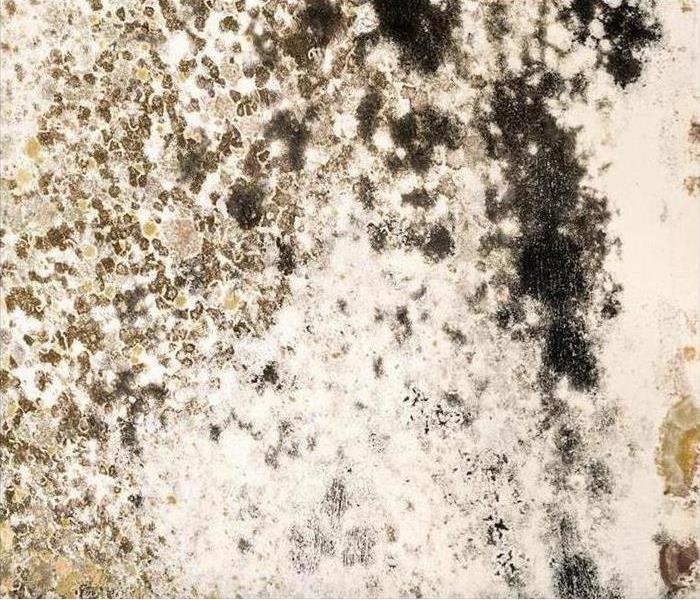 SERVPRO of West Riverside City uses advanced mold remediation techniques and equipment
SERVPRO of West Riverside City uses advanced mold remediation techniques and equipment
Discovery Of Mold Damage
There are several stories about people discovering pieces of the past, some of which were very valuable, while they were in the process of remodeling their home. Others end up finding problems. One of these more unpleasant discoveries sometimes includes different types of damage. It can often result in increased costs instead.
Adding on to your home or upgrading it can end up with the discovery of mold damage. Few construction crews are qualified to handle the disposal of mold contamination. Without an expert in mold remediation and containment, contamination of other areas in your home can happen quite easily. SERVPRO has the ability to work alongside other crews to remediate mold correctly, so future problems do not become a reality.
Our professional team members are trained according to IICRC standards, and then given experience working with other employees. Our customers receive the best of both types of training. When remodeling, or another kind of work, is ongoing, discoveries such as mold damage can be surprising. We can install temporary plastic sheeting if it has not already been put in place, or expand the area contained if needed. As the remodeling crew removes damaged materials, we can dispose of these pieces of drywall, wood, or other material correctly, and then check for more areas that are affected by mold patches.
Giving your family the gift of an improved home is one that can be costly but is also well worth the price. Mold can put a dent in your investment, but the incorrect handling of an infestation of mold can make matters much worse. SERVPRO of West Riverside wants to help you protect your family and your investment from harm. Call us at (951) 351-8033 whenever you find mold growing out of control in your home so we can remediate things correctly for you.
10 Things You Should Know About Mold
10/29/2018 (Permalink)
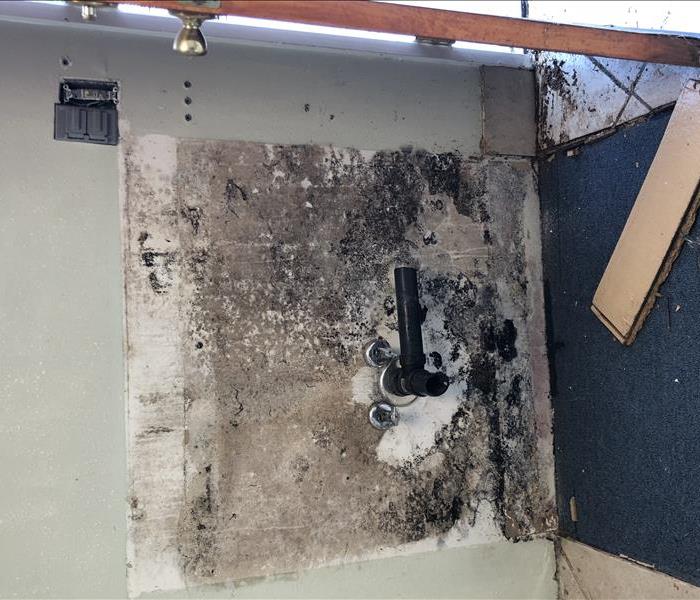 Mold in a residential home in Riverside
Mold in a residential home in Riverside
Tips from our friends from United States Environmental Protection Agency (EPA)
1. Potential health effects and symptoms associated with mold exposures include allergic reactions, asthma and other respiratory complaints.
2. There is no practical way to eliminate all mold and mold spores in the indoor environment; the way to control indoor mold growth is to control moisture.
3. If mold is a problem in your home or school, you must clean up the mold and eliminate sources of moisture.
4. Fix the source of the water problem or leak to prevent mold growth.
5. Reduce indoor humidity (to 30-60%) to decrease mold growth by:
• Venting bathrooms, dryers and other moisture-generating sources to the outside
• Using air conditioners and de-humidifiers
• Increasing ventilation
• Using exhaust fans whenever cooking, dishwashing and cleaning
6. Clean and dry any damp or wet building materials and furnishings within 24-48 hours to prevent mold growth.
7. Clean mold off hard surfaces with water and detergent, and dry completely. Absorbent materials such as ceiling tiles, that are moldy, may need to be replaced.
8. Prevent condensation: Reduce the potential for condensation on cold surfaces (i.e., windows, piping, exterior walls, roof, or floors) by adding insulation.
9. In areas where there is a perpetual moisture problem, do not install carpeting (i.e., by drinking fountains, by classroom sinks, or on concrete floors with leaks or frequent condensation).
10. Molds can be found almost anywhere; they can grow on virtually any substance, providing moisture is present. There are molds that can grow on wood, paper, carpet, and foods.
Contact Us 951-351-8033 to ask a question, provide feedback, or report a problem.
From EPA.gov
SERVPRO - A Qualified Mold Remediation Company
8/1/2018 (Permalink)
Mold Growth in your Home
Mold is a microscopic organism called fungi that can grow anywhere there is a damp or wet environment, a food source (ranging from wood to tile and other organic based materials), and high humidity. If certain types of mold didn’t exist we wouldn’t have cheese or penicillin, but there are other types of mold that can create major health concerns. Some molds growing in your home also produce mycotoxins that can pose serious health risks to humans and animals. When people touch or breathe in these mold spores they can elicit nasal and sinus congestion, induce runny nose and eye irritation, and provoke respiratory problems such as chest tightness and sneezing fits. At SERVPRO West Riverside City we are committed to the protection of your property and the health of your family, so we have cutting-edge mold cleanup and restoration packages to suit your home repair needs.
The first step for eliminating mold is to investigate your home for any sources of major indoor moisture. Pay special attention to piping connected to the roof, plumbing leaks, backed-up sewers, and the space around the humidifier or air conditioning unit. If you are a tenant you want to alert your property manager of potential water damage areas that should be fixed immediately.
One way that you can safeguard your home against mold is to improve the ventilation in your residence. Not all heating or cooling systems circulate fresh air into your home, so in order to help keep your home well-ventilated you should consider using kitchen and bathroom exhaust fans, window or attic fans, or a window air conditioner with the vent control open. If weather permits it’s always helpful to keep the window open as well.
SERVPRO Does Mold Removal and Remediation
If you are suffering from unwanted mold in your home SERVPRO West Riverside City, a quality mold cleaning company, can help alleviate some of your stress. The goal of our dedicated technicians is to make sure you are comfortable in your home, and if we can’t, then we aim to make the process as quick and painless as possible.
Give us a call for a mold inspection. 951-351-8033
Mold Growth Problems Riverside, CA and surrounding areas
7/23/2018 (Permalink)
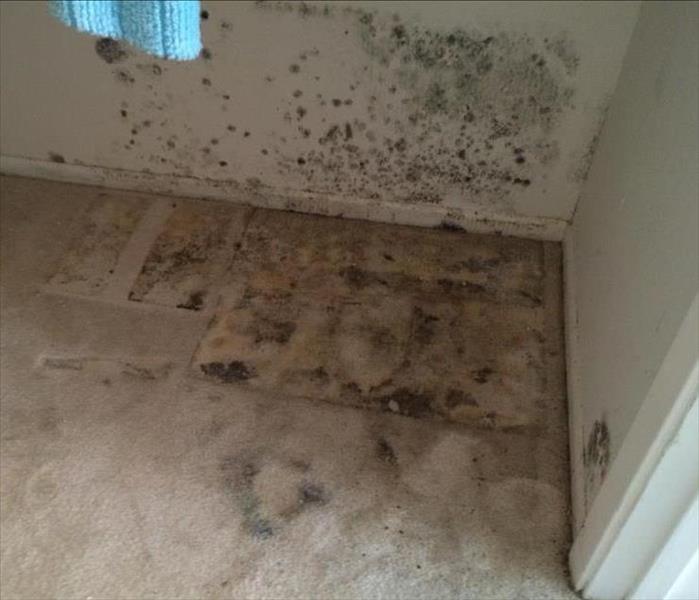 Mold can be very dangerous. Before you do anything to it have someone with mold experience come and take a look at it.
Mold can be very dangerous. Before you do anything to it have someone with mold experience come and take a look at it.
If you suspect that your home or business has a mold problem, SERVPRO of West Riverside City has the training, equipment, and expertise to handle the situation.
What to Do:
Stay out of affected areas.
Turn off the HVAC system and fans.
Contact SERVPRO of Flagler County for mold remediation services.
What Not to Do:
Don’t touch or disturb the mold.
Don’t blow air across any surfaces with visible or suspected mold growth.
Don’t attempt to dry the area yourself.
Don’t spray bleach or other disinfectants on the mold.
Call our office to speak with one of our claim specialists to schedule an appointment with one of our Estimators. From Estimation to Completion, our team is ready to take care of your water damage restoration needs.
If you have a mold problem, call us today 951-351-8033.
Prevent Mold Growth in Bathrooms, Riverside, CA
7/9/2018 (Permalink)
 Mold Growth Behind Bathroom Cabinets
Mold Growth Behind Bathroom Cabinets
Fighting mold in your bathroom? That’s because showers, sinks, bathtubs and toilets are each high producers of lingering moisture, creating the perfect environment for mold to grow in.
The good news is, there are preventative measures you can take to help combat mold growth in these areas, and stop it from spreading to the rest of your home:
- Make sure your bathroom is properly ventilated. Ventilation is key in regulating the amount of moisture in the air and keeps it from settling on surfaces where mold can grow. If you have a fan, make sure it is on or a window is open while you are showering so the steam can be directed away from the rest of the room.
- Once you finish taking a bath or shower, allow your bathroom fan to run for at least 30 minutes longer. This will give the air time to circulate.
- Mildew-resistant materials to the rescue! If you have a shower curtain or window curtains in your bathroom, make sure they are mildew resistant so mold can’t grow on them.
- Wipe down your shower often. Wiping down your shower after using it removes any lingering moisture that otherwise would have no place to go.
- Wash your shower curtain. Many people forget this one, but you should always wash your shower curtain at least once a month! Not only will it keep your bathroom looking fresh and clean, it will help remove any mold spores that could potentially grow and wreak havoc on the material.
- NEVER leave damp laundry on the floor. Or any laundry for that matter. When damp laundry is left on the floor, it creates the perfect breeding ground for mold spores. It also can ruin your clothes!
- Repair any water leaks. If any drains, faucets, or pipes are leaking water, it creates a constant source of moisture for mold to live on and grow from. Fix leaks immediately to reduce the chances of mold.
SERVPRO Helps You Prevent Mold Growth in Bathroom in Riverside, CA.
If you find mold, or suspect you may have mold in your home, give SERVPRO of West Riverside City a call and we will come inspect it for you. 951-351-8033
SERVPRO Offers Mold Damage Remediation in Riverside, CA
6/13/2018 (Permalink)
Mold Prevention
With the summertime heat right around the corner, it isn’t uncommon to find moisture and heat coexisting on the same surfaces in your home. Recently SERVPRO West Riverside City helped a distraught client that was headed out of town before he discovered harmful mold growing in his home.
Our client was initially distressed because he was all set to go away when he noticed the hazardous green and black mold spots but he still didn’t want to cancel his travel plans. The experienced SERVPRO West Riverside City mold damage remediation team immediately rushed to his rescue to create a mold damage repair plan. SERVPRO of West Riverside City technicians identified, assessed, and cleared the mold in the structure of his home by using a specialized anti-microbial disinfectant treatment to prevent the spread of mold spores that can make one sick and spread infectious diseases.
Mold poses the biggest health threat for infants, children, pregnant women, the elderly, and individuals with existing respiratory conditions.
How to find Mold in your Home
One way to detect mold in your home is to look out for any foul, musty odors. Often dangerous mold spores are located in air ducts and wall cavities and mold may not be seen but is still present. Mold grows rapidly in dark damp crevices so the best defense against mold damage is prevention.
- Keep it clean: If you notice any musty odors, which can occur before the mold spots show up, use bleach, borax, or vinegar to disinfect the area thoroughly.
- Do the laundry: During the summer many of us like to go swimming, but don’t leave soiled clothes out in places where they will not dry within an hour.
If you are looking for mold damage repair in Riverside and surrounding areas SERVPRO West Riverside City can help alleviate some of your stress. The goal of our experienced technicians is to make sure you are comfortable in your home, and if we can’t, then we aim to make the process as quick and painless as possible.
Call us at 951-351-8033 for a mold inspection!
Unsure if Mold Is Affecting Your Home? This Checklist can Help.
5/28/2018 (Permalink)
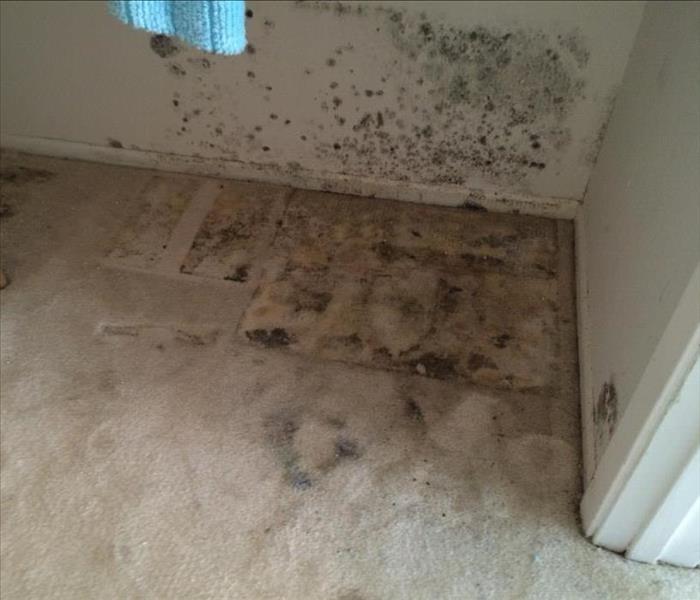 Water Damage Goes Undetected and Mold Starts Growing. SERVPRO of West Riverside was there to help and make this Riverside Home safe to live in again.
Water Damage Goes Undetected and Mold Starts Growing. SERVPRO of West Riverside was there to help and make this Riverside Home safe to live in again.
“You have mold.”
These are words no homeowner ever wants to hear. Not only is mold a hassle to remove, but if it’s not removed properly, it can also cause serious health problems and damage to a home. SERVPRO West Riverside City realizes how hazardous mold can be to a home and its residents. That’s why we offer excellent mold remediation services. However, there are certain warning signs that all homeowners should take into consideration. We at SERVPRO have compiled a checklist of ways to detect mold in their house.
How to Detect Mold
1. Something smells suspicious
Mold has a very distinct smell. The odor typically has a musty or mildew scent to it. When mold is kept contained to one area of your home, you may notice an unpleasant odor when you enter that area. Mold can sometimes live within the walls of your home. This means that while you may not be able to visually detect it, mold can still be growing in your home, so if you smell something strange, this could be a sign of mold.
2. It might not just be seasonal allergies
While it might seem like you only have a little winter cold, you might want to think again. A symptom of mold is that it can oftentimes leave you feeling sick. Depending on how sensitive you are to mold, exposure to mold can cause a runny nose, sneezing, red eyes, skin rashes, shortness of breath and other respiratory issues.
3. Take a look around your house
While not all molds are visible, many of them are. The easiest way to detect mold is by simply taking a look around your house. If you feel like there is a possibility of mold in your home, check out our Home Checklist that covers where you should be on the lookout for mold.
Spotting for Mold
1. The colors of mold
When inspecting for mold, it helps to know what kind of colors you should be looking out for. Mold comes in a variety of colors including, green, grey, brown, white and black. The most common types of mold usually come in the shade of black.
2. Check water source areas
Because mold loves to grow in moist areas, it’s a good idea to look around areas where your water comes from. If you check places like your kitchen sink, laundry room, basement and bathroom early enough, you might be able to protect your home from further mold growth.
3. Look up
Do you find any water spots on your ceiling? This could possibly mean that you have a condensation or humidity problem. The water spots have most likely been caused by a water leak above the ceiling, which means your house could be the victim of mold.
4. Look down
Just like mold can affect your ceilings, it can also affect your flooring. Moisture, dust and dirt make the perfect landing spot for mold to grow. The biggest trappers of dust are typically carpets and tiles. Carpets contain moisture very well, so if you want to prevent mold, it’s important to consistently inspect your flooring for any water damage.
5. Check your walls
Do you have paint peeling or wall discoloration? This is a classic symptom of your wall being exposed to moisture. If you see this, it’s important to really take a closer look at your walls and if necessary, take action immediately. While it might just be the beginning of some tiny mold growth, it could actually be much worse. Mold might be growing behind the wall, and seeing it on the wall’s surface can be a sign that there is a larger problem underneath.
6. Inspect your furniture
There are certain pieces of furniture that molds likes to grab a hold of. Furniture made of wood or other organic materials are common places for mold growth. Upholstered furniture typically holds moisture well, which means it’s a perfect space for mold to grow. One way to prevent mold from reaching your furniture is to keep it away from your walls. If you have mold growing on your walls and your furniture is touching those walls, it is likely that the mold will then grab ahold of your furniture. Because of this, be sure to check inside your cabinets and cupboards as well.
7. Take a look at your windows
During the colder months, windows and window frames can very easily become the victims of mold growth. Due to the cold outside air, condensation frequently forms on windows, which cools the glass. If your windows are dirty, the combination of the moisture and grime add up to be a great spot for potential mold to grow. Be sure to clean your windows on a regular basis. Also, check the area around your windows where the frame meets the wall.
8. Always keep dry clothes
Leaving wet clothes unattended for a long period of time can create mold. Keeping damp towels or wet clothing items for more than a day creates a very good possibility of mold growth.
9. Call SERVPRO!
If you are unsure as to whether or not there is mold in your home, our SERVPRO team can help! We use various professional testing tools and equipment to examine whether or not your house has been exposed to mold.
If by chance you discover mold in any area of your home, call SERVPRO today! We are experts in mold remediation and removal. As soon as we receive your call, we are dedicated to making the remediation process as quick and as smooth as possible. The faster we are able to get to your home, the more affective we can be in removing any signs of mold.
SERVPRO’s Mold Remediation Process
The process of removing mold from your home depends on the amount of mold growth and the types of surfaces on which the mold appears to be. We use certain antifungal and antimicrobial treatments to eliminate mold colonies and to help prevent new colonies from forming. Depending on the severity of the mold damage, SERVPRO will remove mold-infested pieces like drywall and carpeting if needed.
Do’s and Don’ts
When it is determined that you do in fact have mold in your home, the hardest part can be waiting for the removal process to be completed. While it might be difficult, there are certain things that should and should not do while you wait:
Do…
- Stay out of affected areas.
- Turn off the HVAC system and fans.
- Contact a SERVPRO Franchise Professional for mold remediation services.
Don’t…
- Touch or disturb the mold.
- Blow air across any surfaces with visible or suspected mold growth.
- Attempt to dry the area yourself.
- Spray bleach or other disinfectants on the mold.
How to Prevent Mold in the Future
Once the mold is removed from your home, there are certain things homeowners can do to help make sure that the mold does not come back. Here are a few tips on how to prevent mold in the future:
1. Be weary of indoor humidity
Higher than normal indoor humidity can support the growth of mold in a home. We recommend homeowners to keep the indoor humidity below 45 percent.
2. Clean up wet and water damaged areas as soon as possible
Whether it’s a simple water spill or a disastrous flood, it is important to respond immediately to the potential water damage. The sooner you can dry up those water damaged areas, the more likely you can prevent mold from coming pack into your home. As soon as you discover the water damage, give SERVPRO West Riverside a call, as we also specialize in water damage remediation as well.
3. Repair your home’s gutters
If the mold originated from a leaking roof, it is possible that there might be an issue with your gutters. In the future, be sure to clean them on a regular basis. If the damage is severe, you might need to repair or purchase new gutters all together.
4. Increase the airflow in your home
As the cold winter temperatures start to kick in, the air doesn’t hold as much moisture as it does in the warmer months. That leaves the extra moisture to appear on your walls, windows, floors and other surfaces in your home. To prevent this from happening, it is essential to have good airflow in your home. Open doors throughout your home and move your furniture away from walls to let fresh air in and prevent the possibility of mold forming in your home.
Mold in a home will never be welcomed. It smells, it’s hazardous to our health and can be just plain gross. We at SERVPRO of West Riverside City understand that and are dedicated in helping our customers completely remove any and all types of mold in a home. If you discover mold in your house, contact SERVPRO today! 951-351-8033
SERVPRO of West Riverside City Specializes in Mold Remediation
5/16/2018 (Permalink)
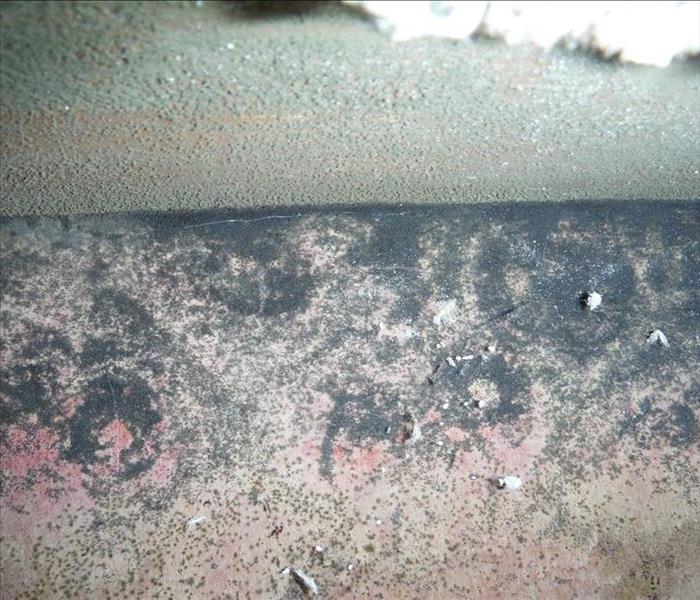 Call us for a mold inspection of your Riverside, CA Home or Business
Call us for a mold inspection of your Riverside, CA Home or Business
Mold Detection
Mold thrives in humid environments with excess water or moisture. It’s no surprise that mold often lurks in the rafters of old and worn roofs. Whether it is damaged drywall due to a leaky roof or harm to your ceiling, attics, floors, or walls, water damage can proliferate the spread of toxic mold if not eradicated promptly and efficiently. SERVPRO West Riverside City specializes in quality mold removal and mold remediation for your home as soon as the presence of mold is identified. Additionally, SERVPRO West Riverside City recognizes that a mold problem is really a moisture control problem and the key to getting rid of mold is identifying the source of excess moisture and squelching it. Therefore, our experienced technicians perform an assessment of your home that focuses on a specialized water damage removal and water damage restoration plan.
Water leaks from a faulty roof on your home can be deadly and they can affect every single room in your home. We know you want each room in your home to have breathable, sanitary air, but when water damage has taken place this is not always possible without outside intervention. Oftentimes the mold growing in your attic has made itself at home and must be attacked with a powerful fungicide. In the kitchen the water damage can increase moisture that can promote mold growth around the kitchen sink. The moisture level in your bathroom may also increase and you want to pay special attention to mold growing on tiles and grout. In the bedrooms, the rise in moisture can be marked by stained vinyl flooring or noticeable condensation on the windowsills.
Mold Remediation
If you are looking for water damage repair in Riverside or surrounding areas, SERVPRO can help alleviate some of your stress. The goal of our experienced technicians is to make sure you are comfortable in your home, and if we can’t, then we aim to make the process as quick and painless as possible.
Mold: The Water Damage Consequence That Keeps Living
4/30/2018 (Permalink)
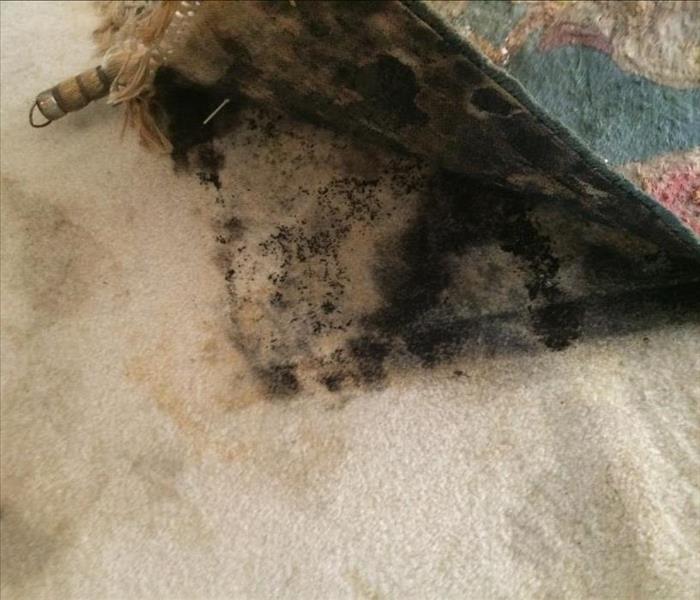 Mold Growth under rug in Bedroom
Mold Growth under rug in Bedroom
An often-unforeseen consequence of a residential water leak is the occurrence of secondary damage. This type of damage is not directly caused by water spillage but is a result of the high humidity environment created by persistent moisture. Black mold is an example of this.
What Is Mold?
Wetness from plumbing leaks can persist for weeks in humid areas such as Riverside, CA causing mold to grow. Mold is a type of microorganism related to yeast, classified in the Fungi kingdom. Fungi are decomposers that occupy an ecological niche, breaking down dead plants and animals, using the detritus for energy, and converting the dead matter into a form that is usable by other creatures via the carbon and nitrogen cycles. This becomes a problem when they start decomposing your house.
Where Does Mold Live?
Fungi thrive in the following environmental conditions:
• Low light
• Moist
• Relatively undisturbed
In the wild, decomposers are an essential part of the ecosystem. Black mold reproduces in the environment by a process called sporulation. Mold spores are produced from hyphae and carry progeny from suitable environment to suitable environment on wind currents or by clinging to the outside of an animal or person’s shoe. When the spore finds a high-humidity environment, chemical signals initiated by moisture start the process of cell division, and a new colony of mold forms. These spores are ubiquitous in the environment, including the air in your home. Secondary damage occurs when mold begins to grow in your house because of residual moisture from a water leak.
How Do You Fix It?
If you find yourself in a situation where black mold is an issue, it is best to call in the professionals. A musty odor or visible growth on walls or ceilings can be indicative of mold growth. Left to grow, mold can cause secondary damage that is worse than damage caused by the initial plumbing leak, but you don’t have to let these moisture-loving fungi turn your home into a tropical rainforest.
Visit http://www.SERVPROwestriversidecity.com for more information on water damage.
Mold Remediation in Riverside, CA
4/23/2018 (Permalink)
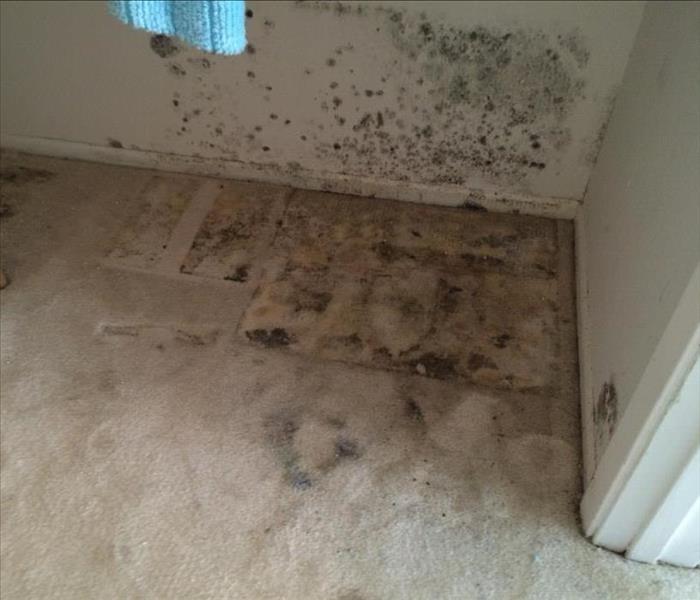 Quick Mold Removal and Remediation in Riverside and surrounding areas. Call us at 951-351-8033
Quick Mold Removal and Remediation in Riverside and surrounding areas. Call us at 951-351-8033
Understanding Mold
Microscopic mold spores exist naturally almost everywhere, indoors and outdoors, so removing all mold from a home or business is impossible. Some restoration businesses advertise “mold removal” and even guarantee to remove all mold, which is a fallacy. Consider the following mold facts:
- Mold is present almost everywhere, indoors and outdoors.
- Mold spores are microscopic and float along in the air, and they may enter your home through windows, doors, or AC/heating systems or even hitch a ride indoors on your clothing or a pet.
- Mold spores thrive on moisture. Mold spores can quickly grow into colonies when exposed to water.
- Before mold remediation can begin, any sources of water or moisture must be addressed. Otherwise the mold may return.
- Let your nose lead the way. Mold often produces a strong, musty odor, and can lead you to possible mold problem areas.
- Even higher than normal indoor humidity can support mold growth. Keep indoor humidity below 45 percent.
Call us if you need Mold Removal and Remediation in your home, apartment or business. 951-351-8033
Process of Mold Removal
4/16/2018 (Permalink)
 Mold Behind Bathroom Cabinets
Mold Behind Bathroom Cabinets
Every mold damage scenario is different and requires a unique solution, but the general mold remediation process stays the same. The steps listed below illustrate our “typical” process:
- Emergency Contact - (951) 351-8033
The mold cleanup and restoration process begins when you call us. Our representative will ask a series of questions to help us determine the necessary equipment, resources, and personnel.
- Inspection and Mold Damage Assessment
We carefully inspect your property for visible signs of mold. Mold feeds on cellulose and water and can be hidden from plain view. We use various technologies to detect mold and hidden water sources.
- Mold Containment
Our professionals use various containment procedures to prevent the spread of mold. We may use advanced containment procedures like negative air chambers to isolate the contaminated area with physical barriers and negative air pressure to keep the mold spores from spreading during the cleanup process. All fans and heating and cooling systems will be turned off to prevent the spread of mold.
- Air Filtration
Our specialized filtration equipment allows our Professionals to capture microscopic mold spores out of the air. We utilize powerful “air scrubbers” and HEPA vacuums to prevent the spread of these mold spores while the mold remediation is in process.
- Removing Mold and Mold-Infested Materials
The mold remediation process depends on the amount of mold growth and the types of surfaces on which the mold appears. We’ll use antifungal and antimicrobial treatments to eliminate mold colonies and to help prevent new colonies from forming. It may be necessary to remove and dispose of mold-infested porous materials, like drywall and carpeting, to remediate heavy mold growth.
- Cleaning Contents and Belongings
We clean your furniture, decorative items, curtains, clothing, and other restorable items affected by mold. We use a variety of cleaning techniques to clean and disinfect your belongings. We’re also trained to remove odors and deodorization using fogging equipment.
- Restoration
Depending on the level of mold damage, drywall, subfloors, and other building materials may have been removed. Restoration may involve minor repairs, such as replacing drywall, painting, and installing new carpet; or it may entail major repairs such as the reconstruction of various areas or rooms in a home or business. The restoration step gets your home or business back to normal.
How we help you find Hidden Mold
4/16/2018 (Permalink)
 We understands mold and mold growth and has the training and expertise to remediate the mold in your home or business.
We understands mold and mold growth and has the training and expertise to remediate the mold in your home or business.
There is no easy way to find hidden mold, but we carefully inspect your property for visible signs of mold. Mold feeds on cellulose and water and can be hidden from plain view. We use various technologies to detect mold and hidden water sources.
This photo shows us doing a inspection hole in the drywall where the water damage had happened earlier. As you can see in the photo we found visible mold and started the remediation process immediately. We might find it hard to open up the drywall to check for mold, but if mold goes undetected it has the potential to cause dangerous health effects and can spread through your property in as little as 48 hours.
We understands mold and mold growth and has the training and expertise to remediate the mold in your home or business.
Call us for an inspection if you have had a water damage and might be concerned about mold.
We help you find hidden mold.
Call us at 951-351-8033.
Mold Removal in Riverside Area
4/10/2018 (Permalink)
 Call us for a free inspection if you need mold remediation.
Call us for a free inspection if you need mold remediation.
SERVPRO of West Riverside City does remediating of mold in homes and businesses in Riverside and surrounding areas. Since microscopic mold spores exist naturally almost everywhere, indoors and outdoors, removing all mold from a home or business is impossible, but we understand mold and mold growth. SERVPRO of West Riverside has the training and expertise to remediate the mold in your home or business.
It is important, especially after a water damage, to quickly address any signs of mold in the home or business. If there is moisture present, growth can start in as little as 48 hours. If not addressed in a timely manner, mold spores can quickly grow into colonies when exposed to water. These colonies may produce allergens and irritants. Mold can also produce a strong, musty odor, and that odor can lead you to possible mold problem areas.
If you discover mold in your home, don’t hesitate to call the professionals who will abide by a remediation process:
- Contact - (951) 351-8033
- Inspection and Mold Damage Assessment
- Mold Containment
- Air Filtration
- Removing Mold and Mold-Infested Materials
- Cleaning Contents and Belongings
Places for Mold Growth
4/9/2018 (Permalink)
 If you suspect mold somewhere, contact SERVPRO for an inspection at 951-351-8033
If you suspect mold somewhere, contact SERVPRO for an inspection at 951-351-8033
Mold spores are present indoors and outdoors and do not pose a major problem until they find an environment that is conducive to growth. If you have noticed a mold or mildew smell in a commercial property, check five of the most common places for signs of visible mold. If you smell mold but cannot find any evidence, you should contact a service in Riverside, CA that provides mold testing services.
1. Near water sources: Mold requires moisture to thrive. Bathrooms and kitchens are more likely to develop a mildew smell and mold than drier and less humid areas. Other parts of the building exposed to water may run the risk of developing mold.
2. Appliances: Appliances that process water such as air conditioners or water heaters are also prone to developing mold. Condensate or drain pans and terminal units are common locations for mold colonies.
3. Ductwork: HVAC systems expose ductwork to humid air. If condensation accumulates in duct linings or a leak occurs, mold can develop. Make sure that air-flow rates are set at an appropriate level.
4. Walls: Condensation, roof leaks or mechanical system leaks can lead to the growth of visible or hidden mold within walls. Moist masonry or wallboard is particularly susceptible to mold growth.
5. Ceiling tiles: Depending on the material, ceiling tiles can absorb moisture that encourages the development of mold. Several common culprits include condensation from pipes, humidity around HVAC vents and leaks.
Inspect any part of a property with a mildew smell for visible mold, but do not try to find hidden mold. If you happen to disturb a colony in your search, you can spread many more mold spores throughout a property. If you are concerned about mold growth in a commercial property in Riverside, CA contact us for an inspection!
Visit http://www.SERVPROwestriversidecity.com for more information on mold.
Mold Removal and Mold Remediation
3/28/2018 (Permalink)
Molds are found in every environment, and mold spores reproduce rapidly when moisture is present. An institute of Medicine study found excessive dampness indoors encourages the growth of molds and other organisms potentially causing a public health problem. The EPA advised that the potential health concerns from molds are important reason to prevent moisture problems leading to mold growth. Possible health effects include runny nose, sneezing, coughing, aggravation of asthma, sore throat, or inflammation of the sinuses.
SERVPRO of West Riverside professionals handle water damages every day and know prompt action is required to prevent mold growth, if there is an ongoing moisture problem in the building, be alert for:
- The presence of visible mold
- Strong, musty odors, which may indicate mold is present
- Any evidence of past moisture problems that might have caused undetected mold growth
- Excessive humidity.
These conditions may require the expertise of a qualified Indoor Air Quality/Environmental Professional to inspect the building for mold growth and water damage problems.
SERVPRO of West Riverside City cares about proper restoration of your structure and, in most water damage situations, can safely restore your building to preloss condition.
Call us for a residential or commercial mold inspection!
Mold Damage and Mold Removal
3/23/2018 (Permalink)
 Get professional help to remediate and removal all mold!
Get professional help to remediate and removal all mold!
The Truth is, It's Everywhere
Let’s face it, mold is everywhere. It can be found indoors and outdoors. It can enter your home or business through windows, vents and HVAC systems. Mold from outdoors can attach to clothing, shoes, pets and can be carried indoors. It grows anywhere, especially where there is moisture. And the worst part is, it can cause a variety of health effects. Children, the elderly, and anyone with respiratory problems are more likely to suffer the effects mold can have.
Mold’s Best Friend:
Water. Any home or business can quickly become infested with mold with the introduction of a water source, like a roof or plumbing leak. Mold can spread throughout a property in as little as 48-72 hours.
“Mold Removal” vs. Remediation
Because mold is everywhere, removing all mold from your home or business is impossible. A qualified restoration company understand the science behind mold and mold growth and knows how to remediate the problem area. So what do you do when you find mold growth in your home or business?
- Step 1: Emergency Contact SERVPRO at 951-351-8033
- Step 2: Inspection and Mold Damage Assessment
- Step 3: Mold Containment
- Step 4: Air Filtration
- Step 5: Removing Mold and Mold-Infested Materials
- Step 6: Cleaning Contents and Belongings
- Step 7: Restoration
Common Places to Find Mold
3/12/2018 (Permalink)
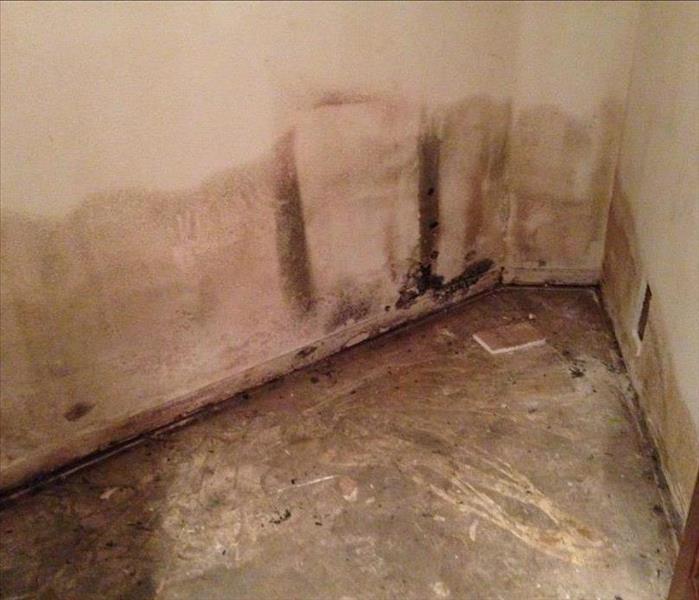
Mold spores are present indoors and outdoors and do not pose a major problem until they find an environment that is conducive to growth. If you have noticed a mold or mildew smell in a commercial property, check five of the most common places for signs of visible mold. If you smell mold but cannot find any evidence, you should contact a service in Riverside, CA that provides mold testing services.
1. Near water sources: Mold requires moisture to thrive. Bathrooms and kitchens are more likely to develop a mildew smell and mold than drier and less humid areas. Other parts of the building exposed to water may run the risk of developing mold.
2. Appliances: Appliances that process water such as air conditioners or water heaters are also prone to developing mold. Condensate or drain pans and terminal units are common locations for mold colonies.
3. Ductwork: HVAC systems expose ductwork to humid air. If condensation accumulates in duct linings or a leak occurs, mold can develop. Make sure that air-flow rates are set at an appropriate level.
4. Walls: Condensation, roof leaks or mechanical system leaks can lead to the growth of visible or hidden mold within walls. Moist masonry or wallboard is particularly susceptible to mold growth.
5. Ceiling tiles: Depending on the material, ceiling tiles can absorb moisture that encourages the development of mold. Several common culprits include condensation from pipes, humidity around HVAC vents and leaks.
Inspect any part of a property with a mildew smell for visible mold, but do not try to find hidden mold. If you happen to disturb a colony in your search, you can spread many more mold spores throughout a property. If you are concerned about mold growth in a commercial property in Riverside, CA contact a service that specializes in mold testing and clean-up as soon as possible.
Visit http://www.SERVPROwestriversidecity.com for more information on mold.
The signs of Black Mold!
2/21/2018 (Permalink)
Usually, you can smell mold before you will ever see it. Mold can be extremely harmful to you, your family and/or your friends.
If you experience sudden health-related problems, you might have a black mold problem.
We suggest you call a mold specialist at SERVPRO to come inspect your home or office and let the franchise professional decide if there is indeed a mold problem or not. SERVPRO has professional grade equipment to handle black mold so your mind can rest.
After the inspection and mitigation of the mold make sure you have the SERVPRO of West Riverside City specialist come back out and follow up on the fact that the mold has been removed.
If you need a qualified company to remove the mold call SERVPRO at 951-351-8033
Mold Containment in Riverside
2/1/2018 (Permalink)
 This is a mold containment to keep spores from spreading.
This is a mold containment to keep spores from spreading.
This home in Riverside, CA was affected by mold in the living room and hallway. The customer had noticed an odd smell and discoloring in their kitchen. They called SERVPRO to inspect for damage and mold was discovered. It had been a slow leak from the sink in the kitchen into the hallway wall. Our crew had to cut through the drywall to find the mold that had spread through part of the insulation. All of the affected materials were removed from the home and then an air scrubber was placed to ensure the air was safe to breathe. The plastic containment in this photo was used to ensure no spreading of mold spores to anywhere else in the home.
Call SERVPRO is you think there might be mold growth in your home!
Mold Containment used when removing mold
1/29/2018 (Permalink)
 This photo shows a containment put up in Riverside, CA home
This photo shows a containment put up in Riverside, CA home
Containment during remediation is used to limit mold releases into the air and surroundings within a building. By allowing your building to have a quarantined area where the mold affected area does not spread allows for the tenant’s space to have greater chance of cleanliness and also improves the efficiency of the mold remediation process. In assessing the mold situation in a building, you want to find where the source is. In identifying the source, it allows for a greater chance for complete removal of the mold. Depending on the size of the mold area it is important to understand what types of containment methods could be used. The three most common types are surface containment, or the area affected, local containment which consists of the area affected and the immediate area, or a full containment which includes the entire building. By properly assessing your unique situation and creating a plan with one of these methods for mold remediation, then you can implement a plan to begin the removal process of the mold within a building.
Mold Damage can Ruin your Home's Framing
1/17/2018 (Permalink)
 Mold Damage in Riverside, CA Home
Mold Damage in Riverside, CA Home
Mold Can Even Damage Your Home's Framing, Just Like This Riverside, CA home.
When given the chance, time and right conditions mold can even damage your home's framing.
Water by itself is harmless but under the right conditions with other materials or substances, it will help foster microbial growth as seen in this Woodburn, Oregon home.
The smallest leaks can create issues over time that eventually damage some materials beyond cleaning and treating to full repairs and replacement.
The sooner you begin the process to dry out the material the better off you'll be. Call SERVPRO of West Riverside City at 951-351-8033 for an inspection and estimate to dry your home.
Our technicians are highly qualified in the services we provide and they're always ready to help.
What to do if you Discover Mold?
1/17/2018 (Permalink)
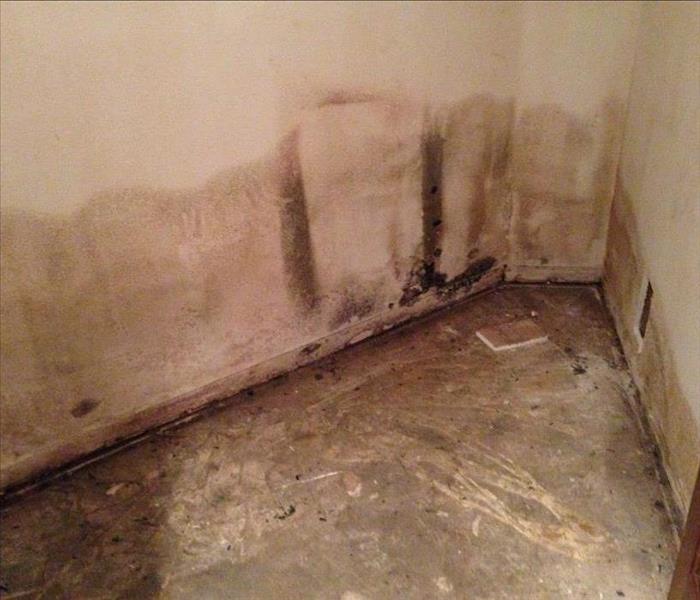 Mold should always be removed safely!
Mold should always be removed safely!
If you see visible mold, do not disturb it. You can inadvertently spread the mold. Dead mold spores can be just as harmful as live spores. Bleach and other cleaners will not get rid of mold, but may actually help the mold spread. When mold is disturbed, the mold can release microscopic mold spores which become airborne and can circulate inside your home.
What to Do:
- Stay out of affected areas.
- Turn off the HVAC system and fans.
- Contact SERVPRO for mold remediation services.
What Not to Do:
- Don’t touch or disturb the mold.
- Don’t blow air across any surfaces with visible or suspected mold growth.
- Don’t attempt to dry the area.
- Don’t spray bleach or other disinfectants on the mold.
If you have noticed any mold growth in your home or office, please don't hesitate to contact SERVPRO to get a professional opinion on what to do next!
Mold Containment In Norco, CA Home
1/17/2018 (Permalink)
 Mold Containment in Norco, CA Home
Mold Containment in Norco, CA Home
Containment during remediation is used to limit mold releases into the air and surroundings within a building. By allowing your building to have a quarantined area where the mold affected area does not spread allows for the tenant’s space to have greater chance of cleanliness and also improves the efficiency of the mold remediation process. In assessing the mold situation in a building, you want to find where the source is. In identifying the source, it allows for a greater chance for complete removal of the mold. Depending on the size of the mold area it is important to understand what types of containment methods could be used. The three most common types are surface containment, or the area affected, local containment which consists of the area affected and the immediate area, or a full containment which includes the entire building. By properly assessing your unique situation and creating a plan with one of these methods for mold remediation, then you can implement a plan to begin the removal process of the mold within a building.
Mold grows year-round
12/29/2017 (Permalink)
 If there is cause for concern with mold growth in your Riverside home, call SERVPRO!
If there is cause for concern with mold growth in your Riverside home, call SERVPRO!
There is a common misconception that mold only grows in the warmer months. The truth is that mold doesn't discriminate based on the climate. Mold has the potential to grow year round, and SERVPRO of West Riverside City is here to help you avoid mold this winter.
Here are some ways that winter mold invades your home or business:
- Cranking up the heat in your home traps the warm air inside with no ventilation. Condensation builds up moisture and affects the relative humidity level. If the weather permits, consider cracking a window for a small amount of time to allow stale air to escape.
- Remove your shoes before entering your home. Dead plants and leaves are a source of heat on the ground and have the potential to release mold spores. Wet shoes in the winter will also release moisture into your carpets. Moisture entering a warm building with poor air flow can cause mold to grow.
- Make sure the windows and doors in your home are properly sealed to avoid moisture entering your home.
If you have concerns about mold growth in your home, please contact us at 951-351-8033 for an inspection.
 Prevents further damage to your property by making it harder for spores to find a new home elsewhere
Prevents further damage to your property by making it harder for spores to find a new home elsewhere






 24/7 Emergency Service
24/7 Emergency Service



